Figma became popular as a versatile open-source software. However, designers should consider if there are more affordable and varied website design alternatives.
This article discusses 11 Figma alternatives that are not only free of cost but their paid plan’s price is much lower than Figma’s $12/ Monthly cost. In addition, 10 out of 11 alternatives are open-source with over 4.2/5 reviews and support a wide range of devices.
I am not a designer by any means, but I did enjoy playing around with Figma. This is why I wanted to explore equally competent tools.
After intense research, I have hand-picked these 11 more affordable tools that distinctly differ from Figma. So, without further ado, let’s dig into the details!
Best Figma Alternatives (2024 – TTWT Designers Choice)
The following list covers the top 11 non-proprietary Figma open-source and free substitutes!
| Rank | Tool | Source | Free Version | Device Compatibility | Link |
| 1 | Penpot | Open | Available | Chrome, Firefox, and WebKit | Here |
| 2 | Framer | Open | Available | Chrome, Safari, Firefox, and Edge | Here |
| 3 | Akira | Open | Available | Linux, Mac, and Windows | Here |
| 4 | Wireflow | Open | Available | Windows and Android | Here |
| 5 | Alva | Open | Available | Windows, MacOS, Linux | Here |
| 6 | Lunacy | Closed | Available | MacOS, Windows, and Linux | Here |
| 7 | Freehand by InVision | Open | Available | iOS 16 and 17 | Here |
| 8 | UXPin | Open | Available on GitHub | Mac, Windows, Browser, Android 5+, and ios 10+ | Here |
| 9 | Sketch | Available | MacOS | Here | |
| 10 | ClipUp | Open | Available | Windows, Mac, and Linux | Here |
| 11 | Adobe XD | Open | Unavailable – 7 days free trial before subscription | Windows and Android Version 8+ | Here |
Now that we have skimmed through the basics of the top 11 tools, let’s go through an elaborative description of each of them – I’ll discuss each of its highlights, limitations, and how the tool is different from Figma:-
1. Penpot – Free & Open Source
| Price | Free Of Cost |
| Free Version | |
| Use Case | Team collaboration, brainstorming, Prototypes, creating user interfaces for websites, and Hand-off developers. |
| Ratings | 4.9/5 — Product Hunt |
Overview – How is Penpot different from Figma?
Unlike Figma’s hidden toolkits and icons, Penpot uses CSS Grid Layout and Flexbox.
That makes the platform’s interface much more intuitive. The open-source model has also launched a desktop offline mode that does not interrupt your workflow, irrespective of internet issues.
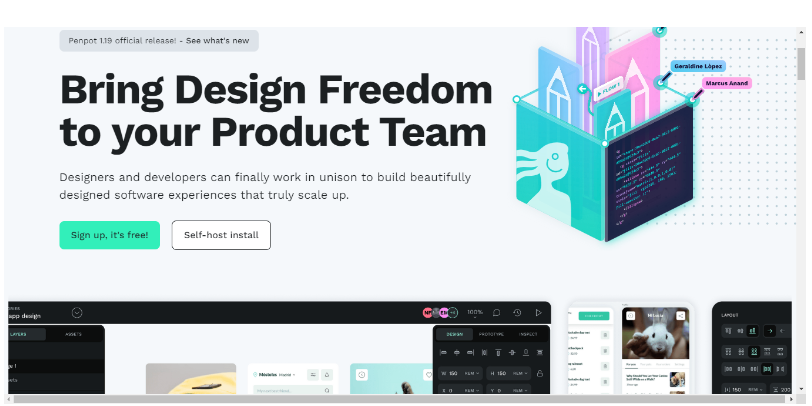
To sum it up, the environment Penpot offers is much more collaborative and secure than Figma, considering it allows both self-installed hostages and server-based.
Penpot Highlights
- Speed up the process by reusing the same elements
- Maximum customization is available
- Scalable Vector Graphics resolves your formatting issue
- Flexible interface that meets the CSS standards
- Seamless file sharing
- Real-time collaboration by dropping comments, sharing screens, and inviting team members
Penpot Limitations
- Interface occasionally glitches
- Dark mode unavailability
- Auto-layout is not available
2. Framer – Free & Open Source
| Price | $5/ Month |
| Free Version | Available |
| Use Case | Build a customized website without code |
| Ratings | 4.5/5 – G2 |
Overview – How is Framer different from Figma?
While both tools support high-quality user control and prototype viewing, Framers is more accessible to learn. Plus, the freemium tool gives you better collaborative options and is even compatible with Smartphone browsers – unlike Figma’s only Windows-support OS.

However, despite Framers’ easy navigation, Figma is faster and supports easy developers hand-off! The only downside is that mastering its evolved features is tricky, but your workflow will be unbeatable once you do that.
Framer Highlights
- A wide range of pre-set layout and design options
- No-code positioning helps you customize the badges, sidebars, and navigation bars.
- Just like Figma, you can copy-paste your design into the interface
- Solid SEO-friendly and performance-boost features
- The starting price for a paid subscription is $7 cheaper than Figma
Framer Limitations
- Lack of code generation
- Complicated developer hand-off
- Occasional bugs
3. Akira UX – Free & Open Source
| Price | $15/ Month |
| Free Version | Available |
| Use Case | Cost management, enhancing your customer service/ relations, and running operations are simple. |
| Ratings | 4/5 – Gartner |
Overview – How is Akira different from Figma?
Akira is a Linux-based platform that provides faster performances and dramatically focuses on the design aspect. Meanwhile, Figma is a proprietary service that offers advanced features that require you to pay for them.
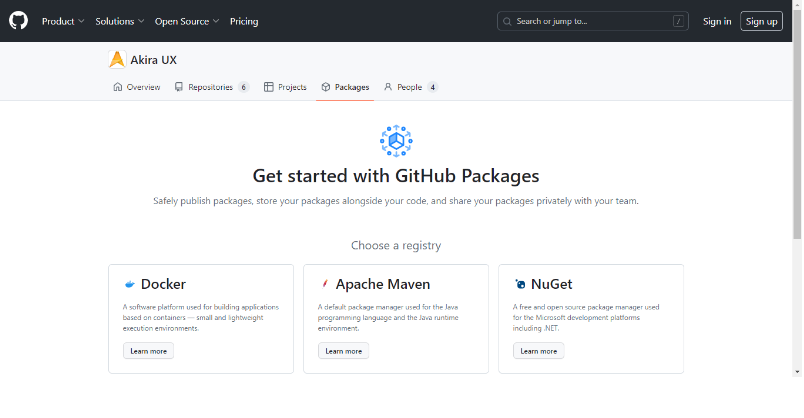
Additionally, Akira primarily focuses on individual design and, at times, local collaboration, whereas Figma is a hardcore real-time collaborative movement.
Akira Highlights
- Multi-cloud environment
- High-level machine learning model
- Cloud-based
- SaaS, API, and Mobile support
- Artificial Intelligence
- Provides training in documentation, live online, in-person, and through videos
Akira Limitations
- Limited Customization
4. Wireflow – Free & Open Source
| Price | Free of Cost |
| Free Version | Available |
| Use Case | Visualize the interface structure, ensuring a user-friendly experience between team and marketing funnels. |
| Ratings | 4.6 /5 – Product Hunt |
Overview – How is Wireflow different from Figma?
Figma offers a set of comprehensive and advanced tools/ features that best suit professional designers. On the other hand, Wireflow’s whole purpose is to provide a simple and easy-to-use interface that caters to beginners or individuals with basic design knowledge.
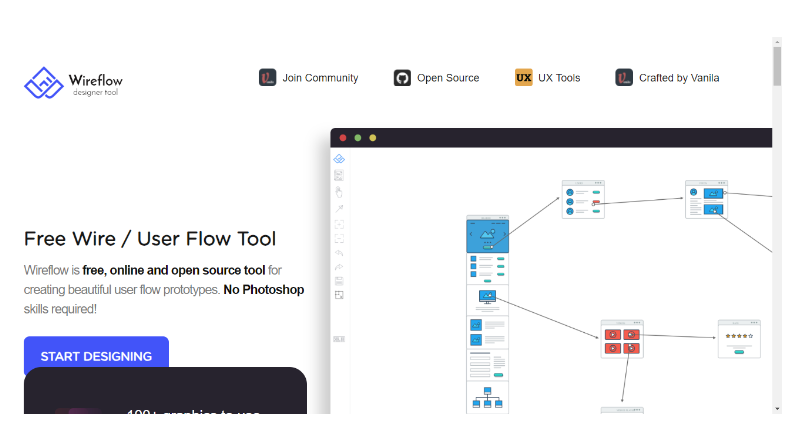
Likewise, the platform is free of cost, unlike Figma’s free and paid plans. However, the free plan has limited features, so you must upgrade to access advanced features.
Wireflow Highlights
- Easy-to-understand interface – Beginner-friendly!
- The user flow is visualizing
- Organize your knowledge with highlights and lists
- Despite not having many unique pages, workflow documents, web apps, and mobile
- Seamless communication between the stakeholders and designers
Wireflow Limitations
- Unlike its competitors, Wireflow has limited features
- Not ideal for complex interface
- Considering it’s a web-based tool, the Wireflow’s performance depends on the stable internet
5. Alva – (Rebranded To Palette Maker) – Free & Open Source
| Price | Free of Cost |
|---|---|
| Free Version | Available |
| Use Case | Creating comprehensive designs, collaborations between designers and developers, Prototyping, Hand-off process, and more. |
| Ratings | 4/5 – Gartner |
Overview – How is Alva different from Figma?
Alva is ideal for creating projects whose cruciality is building design to development hand-off. In contrast, Figma focuses on a broad spectrum of audiences, be it project managers, developers, and designers.
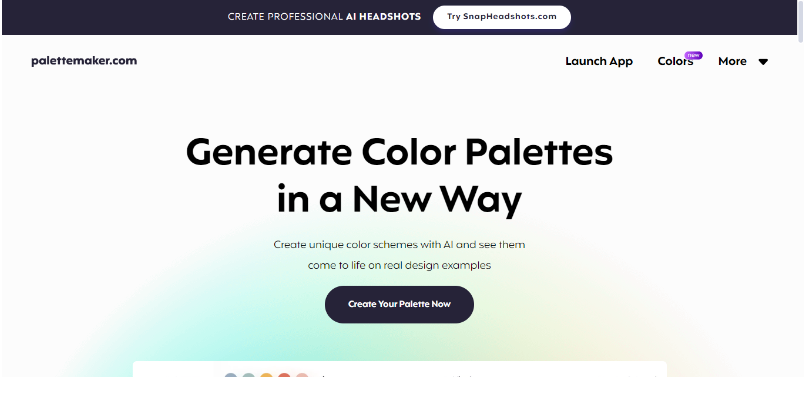
Both platforms are component-based. However, Alva is more into re-using the design while keeping the code and design in sync. Figma is more flexible and promotes designing a wide range of tasks and not just sticking to component-based ones.
Alva Highlights
- Tries to bridge the gap between designers and developers
- Open source and Interactive Prototype
- Seamless synchronization of the design and Code
- You can design with components that are product-ready
- A cloud-based design tool that focuses on collaboration
- Compatible with a wide range of operating systems
Alva Limitations
- People with little to no knowledge of component-based design or even Alva’s templates may have difficulty navigating through the platform.
- Limited library of components
- Large projects or a number of teams might lag your performance.
6. Lunacy – Free But Not Open Source
| Price | Free of Cost |
| Free Version | Available |
| Use Case | Collaboration and Prototyping |
| Ratings | 4.7/5 – Capterra |
Overview – How is Lunacy different from Figma?
Lunacy used to be an open-source software. However, in 2007, the developer removed the rights, considering users were stealing the data and publishing it under a different name.
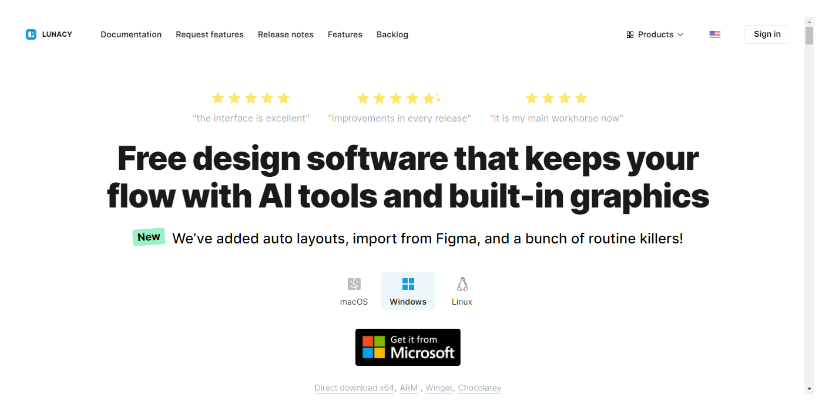
However, keeping that aside, if you are looking for an AI-powered tool that also helps you replace Figma, then Lunacy is your best match. The tool is best admired for its real-time collaboration, seamless prototyping, dropping comments, and extensive template gallery.
Lunacy Highlights
- A wide range of illustrations, icons, and photos
- With the help of a smart layered tree, you can discontinue the layers you cannot see or even adjust the shape’s color.
- Generates auto-updates
- Routine killer helps you save time by finishing off the repeating tasks
- A background remover
- AI Upscaler
- Avatar Generator
- Built-in graphic library
Lunacy Limitations
- Many users reported automatically logging out.
- More free vector-based content
- Integrate graphic media provider.
7. Freehand By Invision – Freemium
| Price | $4/ Month |
| Free Version | Available |
| Use Case | Building design from scratch, jotting ideas on whiteboard, collaborating with team |
| Ratings | 4.3/5 – G2 |
Overview – How is Freehand by InVision different from Figma?
Freehand by InVision pushes users to brainstorm on a whiteboard. The whole motive is for the team to collaborate and create their design by jotting down ideas.
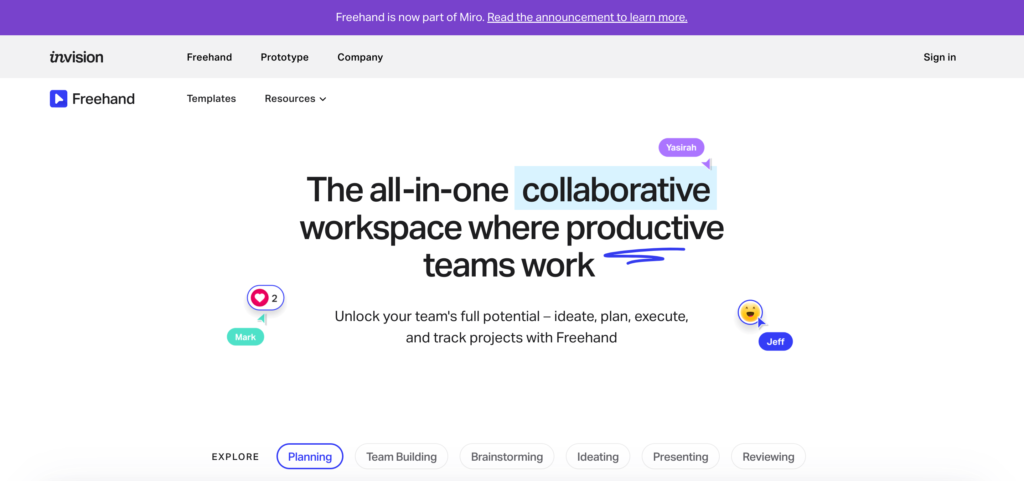
Considering the manual work you do with the platform, unlike Figma’s ready-made designs, there is a considerable price difference, too. Figma charges you $15/ Month, whereas the Freehand InVision costs you $4/ Month.
Freehand by InVision Highlights
- Discuss ideas, brainstorm, and build designs.
- Connect the objects with the help of a connector and further automate the workflow.
- Connecting Freehand with Bidirectional Integration limits the automated change on Canvas through cracks.
- Drag and drop design, multiple views, and Intelligent Canvas
- The collaboration board is visually aesthetic
- Access to features like Buzzers, Flip cards, Leaderboards, and Spinners
Freehand by InVision Limitations
- Unavailability of advanced editing tools
- The login process could be better.
- Unlike Figma’s all-in-one integration, InVision requires switching a few platforms.
8. UXPin – Open Source & Free on GitHub
| Price | $6/ Month – save $24 yearly |
| Free Version | Available |
| Use Case | Seamless collaborations, building prototypes, and developing/maintaining team |
| Ratings | 4.4/5 – Gartner |
Overview – How is UXPin different from Figma?
Unlike Figma, UXPin does not have an extensive integration process. Hence, if you have a large team and require accessing multiple platforms, UXPin might limit your workflow.
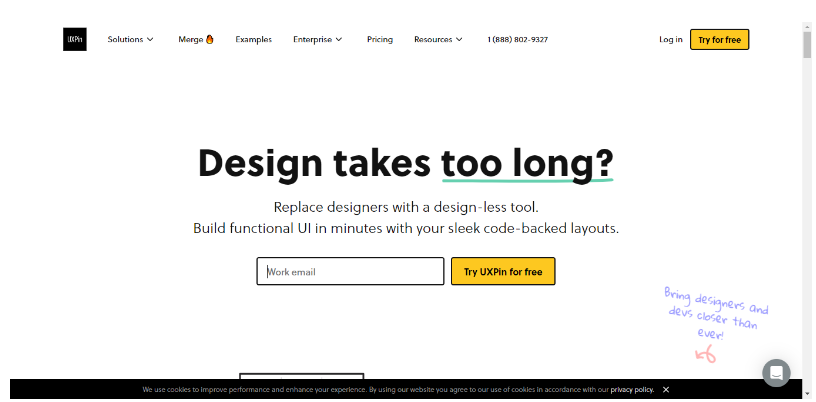
On the flip side, considering UXPin’s advanced features, building complex interfaces is simpler than Figma. Another difference between the two platforms is that Figma is a vector-based design tool, whereas UXPin is a code-based tool for interactive prototyping.
UXPin Highlights
- With the help of UXPin, you can maintain consistency
- Option to design the website from scratch or import templates
- Within a span of a few clicks, you can collaborate/ share your work and get feedback
- The designing process is seamless and supports advanced tools
- Interactive prototypes and the ability to auto-animate elements
- Creating map user flows, wireframes, mocks, etc., does not require much effort
- 14 days free trial, and then you can upgrade to a paid plan
UXPin Limitations
- Beginners may face difficulty while navigating.
- Offline mode is limited
- Depending on the browser, you might experience lag or glitch
9. Sketch – Freemium
| Price | $10/ Month |
| Free Version | Available |
| Use Case | Designed website interface, maintained many teams, customized graphics and logos, etc. |
| Ratings | 4.5/5 – G2 |
Overview – How is Sketch different from Figma?
Most users love Sketch, considering its easy-to-use interface and power-packed features without compromising on the UX! However, unlike Figma, the platform is not accessible for online use. Therefore, you need to download it on your system.

There is a big difference in the device compatibility of both tools – while Figma supports all web-based operating systems, Sketch is only compatible with MacOS.
Sketch Highlights
- Customizable toolbars and shortcuts
- Built-in spell checks
- Drag and drop interface
- Top-notch UX
- An intuitive interface further boosts your productivity as well as creativity
- A wide range of canvas ad templates
Sketch Limitations
- Only available on macOS
- Upon hitting 100 artboards, the platform will lag
- A complex design will drain your memory RAM
- Limited plugin options
10. ClickUp – Freemium But Not Open Source
| Price | $7/ Month |
| Free Version | Available |
| Use Case | Task management, scheduling, time tracking – basically, keeping track of your project/ team. |
| Ratings | 4.7/5 – G2 and Capterra |
Overview – How is ClickUp different from Figma?
Figma and ClickUp differ in terms of their core function. For example, the latter is a productivity and team management software, whereas Figma focuses on prototyping and UX/UI design. In addition, ClickUp helps in organizing, tracking the work, and team planning.
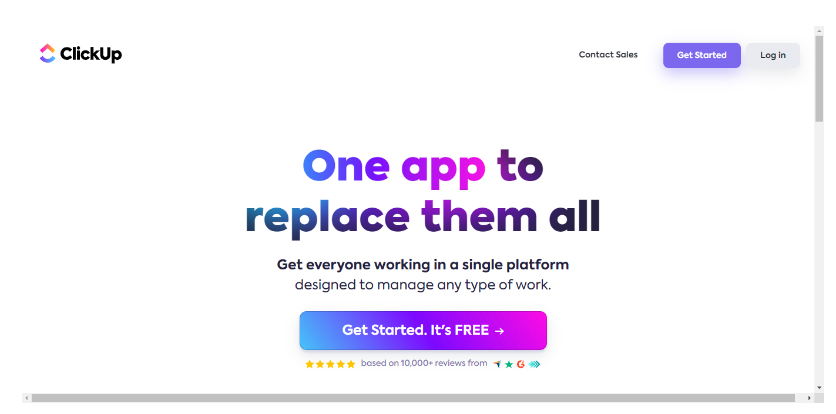
Meanwhile, Figma helps designers create interactive interfaces.
Lastly, compared to Figma, ClickUp is more comprehensive and customizable.
ClickUp Highlights
- A platform for task and project management
- Collaborate with workers in real-time – by project planning, tracking, and organizing.
- Over 1000 template options
- Instant discussions with the help of chat view
- You can collect feedback and design requests
- The platform is highly scalable
- Infinite whiteboard options to brainstorm and collaborate
ClickUp Limitations
- Except for the Enterprise, all ClickUp plans have limitations
- 100 lists/ folder, 100 lists/ space, 5 spaces and 100 folders/ space, and 100K tasks/ list
- Understanding and navigating through the platform is difficult for beginners
11. Adobe XD – Freemium Open Source
| Price | $59.88/ Month |
| Free Version | 7 to 14 Days Free Trial |
| Use Case | Simplify the design hand-off, voice integration in the interface, prototype, wireframe creations, etc. |
| Ratings | 4.6/5 – Capterra |
Overview – How is Adobe XD different from Figma?
Unlike Figma, Adobe XD offers a voice integration that helps designers create a voice-based interface. In addition, the integration process with other cloud services is seamless for Adobe XD.
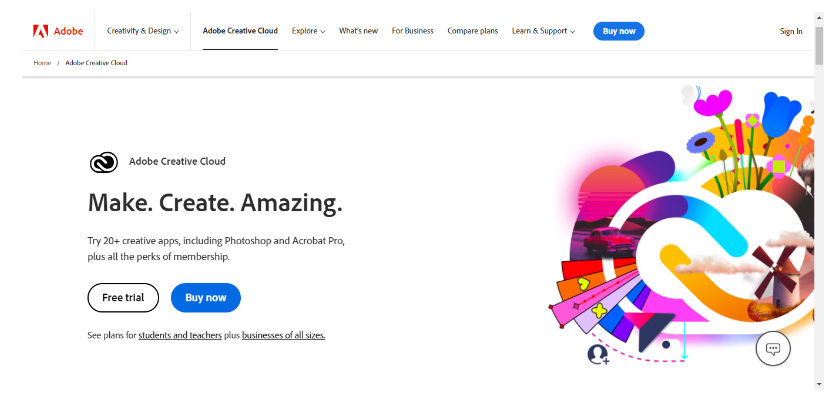
As you know, Figma buffers when dealing with large files. Moreover, beginners may have a difficult time understanding its learning curve. On the other hand, Adobe XD fulfills these roles and even provides a simplified process of design hand-off.
Adobe XD Highlights
- Students and teachers get a 60% discount in the first year – $19.99/ month.
- Save $30 every month by subscribing to the Annual Plan
- Intuitive interface
- Ability to create visually appealing graphics
- Powerful prototypes
- Create screen designs for websites and mobile applications
- Wireframe creation
Adobe XD Limitations
It is no longer available for purchase as a stand-alone application. However, the tool is still active for existing users and those who purchase the Adobe Creative Clouds All-Apps (EXPENSIVE) Subscription – $59.99/ Month.
Wrapping Up: People’s Choice #1 Figma Alternative – Penpot!
The web-based prototyping and website design software is best for anyone struggling with formatting their page. What I loved the most about Penpot was its ability to disperse all the distractions.
However, if you’re still looking for more free-of-cost and open-sourced Figma alternatives, check out my additional recommendations:
- Framer: The web development process is simplified and less time-consuming.
- Akira: A multi-cloud tool for high performance and individual design.
Bonus Alternatives:
Apart from the above three, two more Figma alternatives deserve an honorable mention!
- Adobe XD – Open Source: 7-day free trial ($59.99/ Month). For students/ teachers, the platform offers a 60% discount in the first year – $19.99/ Month.
- Lunacy – Closed Source: This free-of-cost tool is best known for its AI-powered capabilities and offers a wide range of graphic collections, real-time collaborations, and more.
So, what are you waiting for? Pick up any of the recommended Figma alternatives and experience the difference. Not only are these tools FREE, but they have distinct features that Figma itself does not offer.
FAQs
According to real-time testimonials, Penpot is the most voted Figma Alternative, considering its free and open-source software. The platform offers an offline mode and a more secure, collaborative, and intuitive interface.
There isn’t a direct replacement for Figma, considering its all-in-one functionalities: prototyping, collaboration, and UI/UX designs. However, you can opt for Lunacy, renowned for being “AI-POWERED” and having advanced features. Keep in mind the tool is a closed source.
Figma’s popularity has risen in the past few years, as over 77% of UI designers use the platform. According to many reviews, Figma is considered the best due to its all-in-one integration and seamless collaboration.
As per a Redditor, Figma has a lot to offer. However, many designers are holding back from learning all the advanced features, making them stick to Adobe XD. Sure, the latter has more triggers facilitating comprehensive UI designs, but overall, Figma has more advantages.